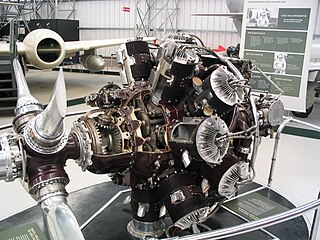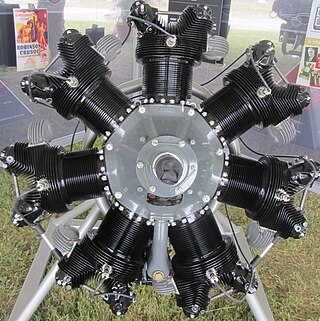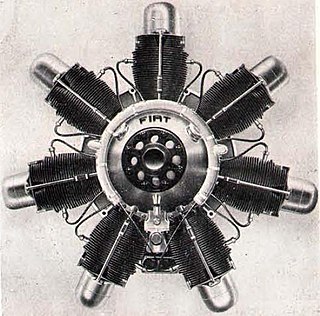
The Bristol Hercules is a 14-cylinder two-row radial aircraft engine designed by Sir Roy Fedden and produced by the Bristol Engine Company starting in 1939. It was the most numerous of their single sleeve valve designs, powering many aircraft in the mid-World War II timeframe.

The Warner Scarab is an American seven-cylinder radial aircraft engine, that was manufactured by the Warner Aircraft Corporation of Detroit, Michigan in 1928 through to the early 1940s. In military service the engine was designated R-420.

The Continental R-670 was a seven-cylinder four-cycle radial aircraft engine produced by Continental displacing 668 cubic inches and a dry weight of 465 lb (211 kg). Horsepower varied from 210 to 240 at 2,200 rpm. The engine was the successor to Continental's first radial engine, the 170 hp Continental A-70. This engine was used on many aircraft in the 1930s and 1940s. The R-670 was widely used in the PT-17 Stearman primary training aircraft of the U.S. military.

The LeBlond radial engines, later produced under the name Ken-Royce, were a family of 3-cylinder, 5-cylinder and 7-cylinder, air-cooled radial engines for aircraft, built in the 1930s by the LeBlond Aircraft Engine Corporation until the operation was sold to Rearwin Airplanes in 1937 and renamed Ken-Royce Engines.

The Franklin O-150 was an American air-cooled aircraft engine of the late 1930s. The engine was of four-cylinder, horizontally-opposed layout and displaced 150 cu in (2 L). The power output was nominally 40 hp (30 kW).

The Walter Mikron is a four-cylinder, air-cooled, inverted straight engine for aircraft.

The Alfa Romeo 110 was an Italian four cylinder air-cooled inverted inline engine for aircraft use, mainly for trainers and light aircraft. The Alfa Romeo 110 was based on the de Havilland Gipsy Major, with approximately 500 units produced. Derivatives of the 110 include the -1, ter and Alfa Romeo 111.

The Kinner K-5 was a popular engine for light general and sport aircraft developed by Winfield B. 'Bert' Kinner. With the boom in civilian aviation after Charles Lindbergh's transatlantic flight the K-5 sold well. The K-5 was a rough running but reliable engine and the K-5 and its derivatives were produced in the thousands, powering many World War II trainer aircraft. The K-5 was followed by the B-5, R-5 and R-55. Military engines were designated R-370

The Kinner B-5 was a popular five cylinder American radial engine for light general and sport aircraft of the 1930s.

The BMW X is a small five-cylinder radial engine for sport and training aircraft. Although this engine proved successful at several large-scale events in 1930, including that year's round-Europe flight, only a few were built.

The Curtiss-Wright CW-1 Junior, originally named the Curtiss-Robertson CR-1 Skeeter is a light sports aircraft produced in the United States in the 1930s. It had been intended to sell it for the price of a mid-range automobile.

The Armstrong Siddeley Cougar was an aero engine developed by Armstrong Siddeley in 1945. The design was a departure from earlier Armstrong Siddeley engines in many ways, it was the company's only nine-cylinder radial design. Although the engine was tested it did not find an aircraft application and was not produced.

The Eaglet 31 was a United States two-seat tandem ultra-light high-winged monoplane of the early 1930s. Intended as a low-cost aircraft, its limited production run relegated it to a footnote in aviation history.

The Walter Pollux is a Czechoslovakian nine-cylinder, air-cooled, radial engine, built by Walter Aircraft Engines for powering light aircraft and that first ran in 1936. The engine produces 240 kW (320 hp) at 1,800 rpm.

The Walter Regulus was a Czechoslovakian five-cylinder, air-cooled radial engine for powering light aircraft that first ran in 1934. The engine produced 186 kW.

The Avia Rk.17 was a 9-cylinder radial aircraft engine, developed from the 7-cylinder Avia Rk.12, with a rated output of 270 kW (360 hp). The Rk.17 was one of Avia's own designs and was built in Czechoslovakia in the 1930s.

The Guiberson A-1020 is a four-stroke diesel radial engine developed for use in aircraft and tanks.

The Fiat A.55 was a seven-cylinder, air-cooled radial engine developed in Italy in the 1930s as a powerplant for aircraft.

The Fiat A.53 was a seven-cylinder, air-cooled radial piston engine developed in Italy in the 1930s as a powerplant for aircraft.

The Astro 7 was a seven-cylinder radial aircraft engine built by Isotta Fraschini in the 1930s.





















